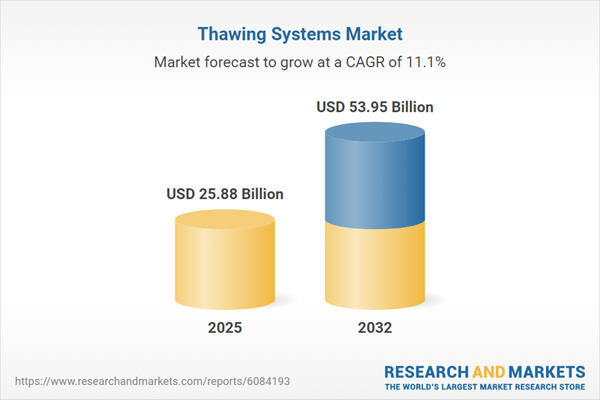Speak directly to the analyst to clarify any post sales queries you may have.
The thawing systems market is evolving rapidly as advanced technologies reshape operations in sectors that demand strict precision, safety, and efficiency. For senior leaders navigating regulatory requirements or scaling operations, choosing the right thawing solution is mission-critical.
Market Snapshot: Thawing Systems Market Size and Growth
The thawing systems market grew from USD 23.27 billion in 2024 to USD 25.88 billion in 2025. It is projected to continue expanding at a CAGR of 11.08%, reaching USD 53.95 billion by 2032. Investment momentum remains strong, powered by end users embracing stringent safety standards, new technologies, and improved process control. The primary keyword, thawing systems market, is increasingly relevant as regulated industries pursue reliable workflow and product quality.
Scope & Segmentation
This report covers a comprehensive range of applications, technologies, deployment models, user environments, capacities, and regional markets. The segmentation reflects the breadth of solutions and adoption drivers.
- Application Areas: Biotechnology (bioprocessing, genomics, pharma), food service (corporate catering, event catering), hotels (boutique, budget, luxury), and restaurants (casual, fine dining, quick service) all demand precision thawing for product integrity and compliance. Healthcare implementation spans clinics, diagnostic labs, and hospitals, while research covers both academic and industrial domains.
- Technology Types: Solutions include infrared (far infrared, short wave), microwave (batch, continuous), ultrasonic (high frequency, low frequency), and water bath (circulating, conventional) technologies, each targeting unique customer challenges.
- Deployment Models: Benchtop (double door, single door), floor standing (multi chamber, single chamber), and portable units provide flexibility for various facility sizes and operational needs.
- End User Profiles: Segment relevance extends from food processing (bakery, dairy, meat—fresh and processed) to diverse hospitality and laboratory environments (cafeterias, fast food, fine dining, hospitals, laboratories).
- Capacity Categories: Systems span high capacity (>2000 L, 1000-2000 L), medium capacity (500-750 L, 750-1000 L), and low capacity (200-500 L, <200 L) tiers to address different operational scales.
- Regional Coverage: Detailed analysis encompasses the Americas (US, Canada, Mexico, Brazil, Argentina, Chile, Colombia, Peru), Europe/Middle East/Africa (UK, Germany, France, Russia, Italy, Spain, Netherlands, Sweden, Poland, Switzerland, UAE, Saudi Arabia, Qatar, Turkey, Israel, South Africa, Nigeria, Egypt, Kenya), and Asia-Pacific (China, India, Japan, Australia, South Korea, Indonesia, Thailand, Malaysia, Singapore, Taiwan).
- Key Companies: Profiling includes Thermo Fisher Scientific, Cytiva, Helmer Scientific, BioCision, B Medical Systems, Sakura Finetek, Grant Instruments, Medelpharm, Catalyst Ortho, and AST Product Inc.
Key Takeaways
- Advanced thawing technologies, including infrared and ultrasonic systems, are addressing longstanding contamination and uniformity challenges across demanding sectors like biotechnology and food processing.
- Digital controls and sensor integration are enabling real-time monitoring and predictive adjustments, which enhance efficiency and align with Industry 4.0 trends for connectivity and traceability.
- Equipment vendors and service providers are reshaping solution delivery through bundled offerings encompassing installation, calibration, and maintenance, improving compliance and user support.
- Segmented applications demand tailored solutions—bioprocessing prioritizes precision, while event catering and field research focus on portability and cycle speed.
- Regional dynamics remain pronounced, with North America and Europe driven by regulatory and modernization imperatives, Asia-Pacific benefiting from research funding and technology adoption, and Latin America exploring scalable solutions for industrial growth.
- Differentiation among competitors increasingly depends on service integration, modularity, and digital feature sets, not just core technology.
Tariff Impact: Adapting to Global Shifts
Newly announced US tariffs effective in 2025 are set to influence global supply chains, raising input costs for manufacturers reliant on imported heating elements and control modules. Companies with localized or vertically integrated supply chains can mitigate these effects, while vendors are exploring strategic inventories and contract negotiations to anchor rates. This tariff shift is also driving design efficiency—modular architectures and reduced part counts are gaining traction to streamline sourcing and future-proof procurement.
Methodology & Data Sources
This market intelligence is grounded in primary research with executives, engineers, and quality specialists, structured interviews, and validated with secondary data from technical journals, regulatory filings, patents, and trade associations. Quantitative and qualitative inputs were cross-checked for consistency and reliability.
Why This Report Matters
- Provides strategic clarity for senior decision-makers on optimal technology selection, deployment, and risk management in thawing system operations.
- Delivers actionable competitive intelligence to inform capital planning, supply chain resilience, and market entry or expansion initiatives.
Conclusion
With evolving compliance standards and technology options, selecting the right thawing system is essential for operational excellence. This report equips leaders with the intelligence needed to strengthen decision-making and sustain long-term value.
Table of Contents
3. Executive Summary
4. Market Overview
7. Cumulative Impact of Artificial Intelligence 2025
Companies Mentioned
The companies profiled in this Thawing Systems market report include:- Thermo Fisher Scientific Inc.
- Cytiva US Inc.
- Helmer Scientific Inc.
- BioCision Inc.
- B Medical Systems S.à r.l.
- Sakura Finetek U.S.A., Inc.
- Grant Instruments (Cambridge) Ltd.
- Medelpharm SA
- Catalyst Ortho LLC
- AST Product Inc.
Table Information
| Report Attribute | Details |
|---|---|
| No. of Pages | 198 |
| Published | October 2025 |
| Forecast Period | 2025 - 2032 |
| Estimated Market Value ( USD | $ 25.88 Billion |
| Forecasted Market Value ( USD | $ 53.95 Billion |
| Compound Annual Growth Rate | 11.0% |
| Regions Covered | Global |
| No. of Companies Mentioned | 11 |









